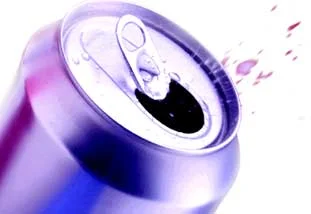Most cans are made from aluminium.
Aluminium is a grey metal that is very light and very strong.
Aluminium is made from a rock called bauxite (say:borx-ite)
The bauxite is crushed and melted in a furnace
Aluminium cans keep fizzy drink fizzy.
What is aluminium?
Aluminium is made from a rock called bauxite that is dug from under the ground in mines. The rock is crushed and then heated in furnaces at a factory to turn it into aluminium. Aluminium is a grey metal.
Bauxite is dug out of the ground in mines like this. Forests are removed first! Getty Images
Aluminium cans are good containers for soft drinks because they are light and easy to transport. The metal can also be used as a container for oils and other liquids.
Aluminium was first used to make cans in 1957.
Aluminium cans and our environment
The good!
Aluminium cans can be recycled. After they are collected, they can be melted in a furnace and then used to make new cans.
Recycling cans is good for the environment. ©Getty Image
Recycling aluminium cans saves energy because it takes a lot of electricity to turn bauxite into aluminium. It takes less energy to recycle the old aluminium cans to make new ones.
The bad!
Aluminium cans pollute our environment and can be dangerous when left lying around.
Forests are cleared away when bauxite is mined.
Mining causes damage to the environment.
However
Recycling the cans helps our environment because less bauxite will be needed and some forest will be saved.
Watch about aluminium cans being recycled at a recycling depot
© Getty images
Some properties of aluminium
Aluminium is light.
It is strong.
It can be made into many shapes.
It is not magnetic.
It is an excellent conductor of heat and electricity. (this means that electricity and heat flow easily through it)
It has a thin layer on the surface which stops air and water getting into the metal which means it will resist corrosion (rust).
Other uses for aluminium
Aluminium is used to make CDs, cars, refrigerators, kitchenware, cooking foil, electric power lines and cables, packaging for food and medicine, computers, furniture and aircrafts.




